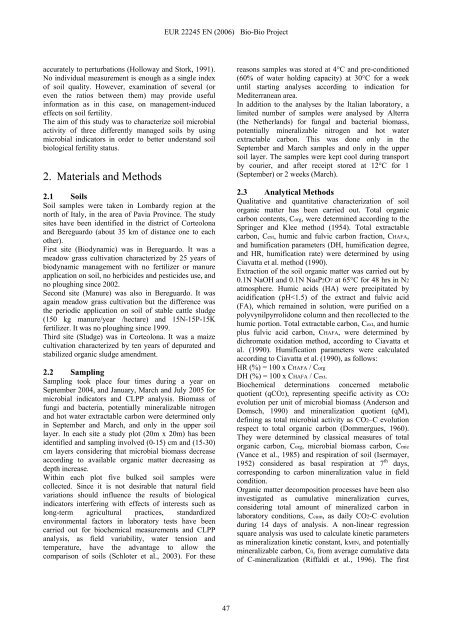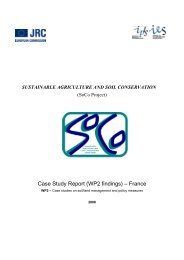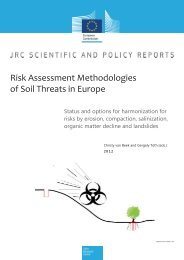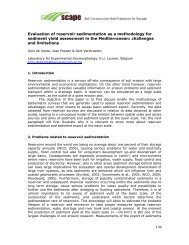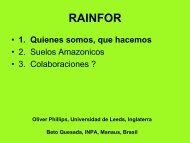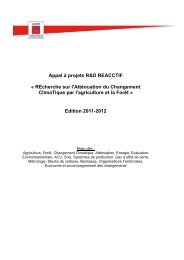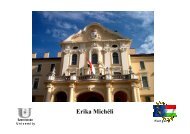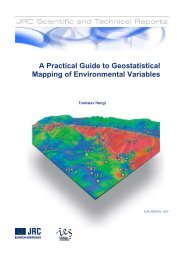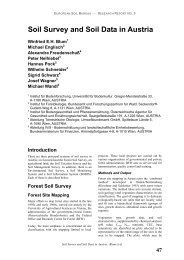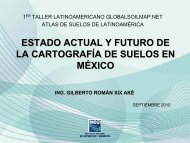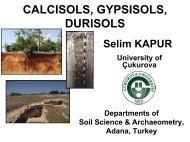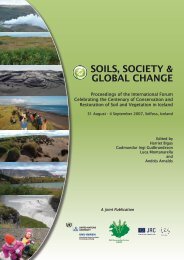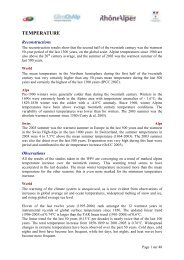Bio - Bio Project - European Soil Portal - Europa
Bio - Bio Project - European Soil Portal - Europa
Bio - Bio Project - European Soil Portal - Europa
You also want an ePaper? Increase the reach of your titles
YUMPU automatically turns print PDFs into web optimized ePapers that Google loves.
accurately to perturbations (Holloway and Stork, 1991).<br />
No individual measurement is enough as a single index<br />
of soil quality. However, examination of several (or<br />
even the ratios between them) may provide useful<br />
information as in this case, on management-induced<br />
effects on soil fertility.<br />
The aim of this study was to characterize soil microbial<br />
activity of three differently managed soils by using<br />
microbial indicators in order to better understand soil<br />
biological fertility status.<br />
2. Materials and Methods<br />
2.1 <strong>Soil</strong>s<br />
<strong>Soil</strong> samples were taken in Lombardy region at the<br />
north of Italy, in the area of Pavia Province. The study<br />
sites have been identified in the district of Corteolona<br />
and Bereguardo (about 35 km of distance one to each<br />
other).<br />
First site (<strong>Bio</strong>dynamic) was in Bereguardo. It was a<br />
meadow grass cultivation characterized by 25 years of<br />
biodynamic management with no fertilizer or manure<br />
application on soil, no herbicides and pesticides use, and<br />
no ploughing since 2002.<br />
Second site (Manure) was also in Bereguardo. It was<br />
again meadow grass cultivation but the difference was<br />
the periodic application on soil of stable cattle sludge<br />
(150 kg manure/year /hectare) and 15N-15P-15K<br />
fertilizer. It was no ploughing since 1999.<br />
Third site (Sludge) was in Corteolona. It was a maize<br />
cultivation characterized by ten years of depurated and<br />
stabilized organic sludge amendment.<br />
2.2 Sampling<br />
Sampling took place four times during a year on<br />
September 2004, and January, March and July 2005 for<br />
microbial indicators and CLPP analysis. <strong>Bio</strong>mass of<br />
fungi and bacteria, potentially mineralizable nitrogen<br />
and hot water extractable carbon were determined only<br />
in September and March, and only in the upper soil<br />
layer. In each site a study plot (20m x 20m) has been<br />
identified and sampling involved (0-15) cm and (15-30)<br />
cm layers considering that microbial biomass decrease<br />
according to available organic matter decreasing as<br />
depth increase.<br />
Within each plot five bulked soil samples were<br />
collected. Since it is not desirable that natural field<br />
variations should influence the results of biological<br />
indicators interfering with effects of interests such as<br />
long-term agricultural practices, standardized<br />
environmental factors in laboratory tests have been<br />
carried out for biochemical measurements and CLPP<br />
analysis, as field variability, water tension and<br />
temperature, have the advantage to allow the<br />
comparison of soils (Schloter et al., 2003). For these<br />
EUR 22245 EN (2006) <strong>Bio</strong>-<strong>Bio</strong> <strong>Project</strong><br />
47<br />
reasons samples was stored at 4°C and pre-conditioned<br />
(60% of water holding capacity) at 30°C for a week<br />
until starting analyses according to indication for<br />
Mediterranean area.<br />
In addition to the analyses by the Italian laboratory, a<br />
limited number of samples were analysed by Alterra<br />
(the Netherlands) for fungal and bacterial biomass,<br />
potentially mineralizable nitrogen and hot water<br />
extractable carbon. This was done only in the<br />
September and March samples and only in the upper<br />
soil layer. The samples were kept cool during transport<br />
by courier, and after receipt stored at 12°C for 1<br />
(September) or 2 weeks (March).<br />
2.3 Analytical Methods<br />
Qualitative and quantitative characterization of soil<br />
organic matter has been carried out. Total organic<br />
carbon contents, Corg, were determined according to the<br />
Springer and Klee method (1954). Total extractable<br />
carbon, Cext, humic and fulvic carbon fraction, CHAFA,<br />
and humification parameters (DH, humification degree,<br />
and HR, humification rate) were determined by using<br />
Ciavatta et al. method (1990).<br />
Extraction of the soil organic matter was carried out by<br />
0.1N NaOH and 0.1N Na4P2O7 at 65°C for 48 hrs in N2<br />
atmosphere. Humic acids (HA) were precipitated by<br />
acidification (pH


